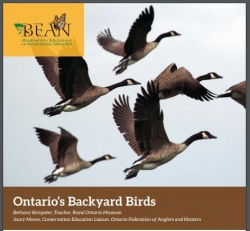Search for Resources
Description
This resource contains five activities to help students develop into young birders. Students will explore bird classification by sorting and categorizing birds, and use the free Cornell Lab Merlin Bird ID app to support bird identification. The Merlin Bird ID app allows users to either take a photo of a bird or follow a step-by-step process to select options based on observed identification features. These two identification options let students practice bird identification by examining key identification features in birds.
Students will then have the chance to assess biodiversity in different habitats, design bird feeders to appeal to a specific species, and participate in a citizen science program.
Students will:
- categorize and sort different types of birds
- go outside and use the Merlin Bird ID app to photograph and identify birds in their school’s neighbourhood.
- observe and identify as many birds as possible using the app in different habitats.
- record their findings and observations about behaviour, location, weather in a field notebook.
- research the habitat requirements, behaviour, and diet of a local bird species
- design and build a bird feeder to appeal to their specific species.
- participate in one of the citizen science bird programs, by contributing valuable data to aid in bird research and conservation
Citizen Science Bird programs vary by region, but listed below are three examples
Project FeederWatch -This project runs from November to April. Over the course of the winter, participants periodically record the birds they see at their feeders.
The Christmas Bird Count - This project, started in 1900, is North America’s longest-running citizen science project.
The Great Backyard Bird Count - this citizen science project was the first to collect and display online data in near real-time. This project takes place each February
General Assessment
Recommendation of how and where to use it
These easy to implement bird activities provide outdoor learning experiences that support science outcomes in grades 3 to 6. The activities provide an excellent introduction to biodiversity and bird identification.
Relevant Curriculum Units
The following tool will allow you to explore the relevant curriculum matches for this resource. To start, select a province listed below.
- Step 1Select a province
- Alberta
- Step 2Select a grade level
- Grade 4
- Step 3Select a subject
- Science
- Step 4Relevant matches
- Living Systems: Understandings of the living world, Earth, and space are deepened through investigating natural systems and their interaction
- Grade 5
- Step 3Select a subject
- Science
- Step 4Relevant matches
- Wetland Ecosystems
- British Columbia
- Manitoba
- Newfoundland & Labrador
- Northwest Territories
- Nova Scotia
- Step 2Select a grade level
- Grade 4
- Step 3Select a subject
- Information Technology
- Step 4Relevant matches
- Information and Communication Technology 4: Productivity
- Information and Communication Technology 4:Research, Innovation, Problem Solving, and Decision making
- Science
- Step 4Relevant matches
- Science 4: Habitats
- Grade 5
- Step 3Select a subject
- Information Technology
- Step 4Relevant matches
- Information and Communication Technology 5: Productivity and Innovation
- Information and Communication Technology 5: Research, Problem Solving and Decision Making
- Grade 6
- Step 3Select a subject
- Information Technology
- Step 4Relevant matches
- Information and Communication Technology 6: Research, Problem Solving and Decision Making
- Science
- Step 4Relevant matches
- Science 6: Diversity of Life
- Nunavut
- Ontario
- Step 2Select a grade level
- Grade 4
- Step 3Select a subject
- Science & Technology
- Step 4Relevant matches
- Life Systems: Habitats and Communities
- Grade 6
- Step 3Select a subject
- Science & Technology
- Step 4Relevant matches
- Life Systems: Biodiversity
- Prince Edward Island
- Quebec
- Step 2Select a grade level
- Grade 3
- Step 3Select a subject
- Science & Technology
- Step 4Relevant matches
- Living Things
- Grade 4
- Step 3Select a subject
- Science & Technology
- Step 4Relevant matches
- Living Things
- Grade 5
- Step 3Select a subject
- Science & Technology
- Step 4Relevant matches
- Living Things
- Grade 6
- Step 3Select a subject
- Science & Technology
- Step 4Relevant matches
- Living Things
- Saskatchewan
- Yukon Territory
Themes Addressed
Ecosystems (3)
- Appreciating the Natural World
- Biodiversity
- Habitat Loss

